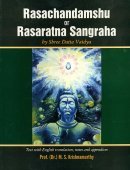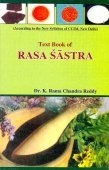Bida, Biḍa, Biḍā: 13 definitions
Introduction:
Bida means something in Hinduism, Sanskrit, Marathi, Hindi, biology. If you want to know the exact meaning, history, etymology or English translation of this term then check out the descriptions on this page. Add your comment or reference to a book if you want to contribute to this summary article.
In Hinduism
Ayurveda (science of life)
Rasashastra (Alchemy and Herbo-Mineral preparations)
Source: Wisdom Library: Rasa-śāstraBiḍa (बिड):—Sanskrit name for one of the drugs belonging to the Sādhāraṇarasa group, according to the Rasaprakāśasudhākara: a 13th century Sanskrit book on Indian alchemy, or, Rasaśāstra and other similar texts. Biḍa has medicinal and alchemical applications, such as that it removes all the doṣas (‘bad effects’)
Source: Indian Journal of History of Science, 31(4), 1996: MūṣāvijñānaBiḍa (बिड) is a preparation of various alkalies, acids, salts etc. According to the Rasaratnasamuccaya 10.12, the Yogamūṣā was made of burnt chaff, powdered and burnt coals, earth from a place where white ants abound, and a biḍa which is a preparation of various alkalies, acids, salts etc.
Dietetics and Culinary Art (such as household cooking)
Source: Shodhganga: Dietetics and culinary art in ancient and medieval IndiaBiḍa (बिड) or Viḍa refers to “black salt”, according to the Mahābhārata Anuśāsanaparva 91.41, and is commonly found in literature dealing with the topics of dietetics and culinary art, also known as Pākaśāstra or Pākakalā.—We cannot see any reference to the salt in Ṛgveda. But most of the non-Ṛgvedic Saṃhitas, Brāhmaṇas and Upaniṣads refer to salt in the name of lavaṇa or saindhava. Mahābhārata refers the non-usage of viḍa (biḍa) and black salt in śrāddha ceremonies. According to Mahābhārata (Anuśāsanaparva 161.99), eating salt in the palms of one’s hands and eating salt at night should be avoided.

Āyurveda (आयुर्वेद, ayurveda) is a branch of Indian science dealing with medicine, herbalism, taxology, anatomy, surgery, alchemy and related topics. Traditional practice of Āyurveda in ancient India dates back to at least the first millenium BC. Literature is commonly written in Sanskrit using various poetic metres.
Purana and Itihasa (epic history)
Source: Cologne Digital Sanskrit Dictionaries: The Purana IndexBida (बिद).—A Pravara of the Bhārgavas.*
- * Matsya-purāṇa 6. 20.

The Purana (पुराण, purāṇas) refers to Sanskrit literature preserving ancient India’s vast cultural history, including historical legends, religious ceremonies, various arts and sciences. The eighteen mahapuranas total over 400,000 shlokas (metrical couplets) and date to at least several centuries BCE.
Biology (plants and animals)
Source: Google Books: CRC World Dictionary (Regional names)1) Bida in India is the name of a plant defined with Mimosa rubicaulis in various botanical sources. This page contains potential references in Ayurveda, modern medicine, and other folk traditions or local practices It has the synonym Mimosa mutabilis Roxb. (among others).
2) Bida is also identified with Salix denticulata It has the synonym Salix elegans Host, nom. illeg. (etc.).
Example references for further research on medicinal uses or toxicity (see latin names for full list):
· Enum. Pl. (1822)
· Encyclopédie Méthodique, Botanique (1783)
· Fl. Austriac. (1831)
· Proc. Indian Acad. Sci., Pl. Sci. (1990)
· Hortus Bengalensis (1814)
· Kongliga Svenska Vetenskapsakademiens Handlingar (1850)
If you are looking for specific details regarding Bida, for example pregnancy safety, health benefits, extract dosage, chemical composition, side effects, diet and recipes, have a look at these references.

This sections includes definitions from the five kingdoms of living things: Animals, Plants, Fungi, Protists and Monera. It will include both the official binomial nomenclature (scientific names usually in Latin) as well as regional spellings and variants.
Languages of India and abroad
Marathi-English dictionary
Source: DDSA: The Molesworth Marathi and English Dictionarybidā (बिदा).—p ( A) Sent away; dismissed; permitted to depart--a visitor. v kara.
--- OR ---
bīḍa (बीड).—n Iron-ore. 2 The mass of this ore upon which sheets of copper &c. are beaten out. 3 A cart-rope. 4 Bitloben or black salt. See baḍalavaṇa.
--- OR ---
bīḍa (बीड).—n (vīḍa from viḍī Ring) Measure, model, pattern. Ex. hyā biḍācā dhōtarajōḍā asalā kiṃvā tyā biḍācēṃ pāgōṭēṃ asalēṃ tara kāḍha.
Source: DDSA: The Aryabhusan school dictionary, Marathi-Englishbīḍa (बीड).—n Iron-ore. A cart-rope. n Model. Ex. hyā bīḍācā dhōtarajōḍā.
--- OR ---
bīda (बीद).—f A street or lane.
Marathi is an Indo-European language having over 70 million native speakers people in (predominantly) Maharashtra India. Marathi, like many other Indo-Aryan languages, evolved from early forms of Prakrit, which itself is a subset of Sanskrit, one of the most ancient languages of the world.
Sanskrit dictionary
Source: DDSA: The practical Sanskrit-English dictionaryBiḍa (बिड).—A kind of salt.
Derivable forms: biḍam (बिडम्).
Source: Cologne Digital Sanskrit Dictionaries: Monier-Williams Sanskrit-English DictionaryBida (बिद):—[from bind] m. (also written vida) Name of a man, [Pāṇini 4-1, 104] [plural] his family, [Āśvalāyana-śrauta-sūtra]
[Sanskrit to German]
Sanskrit, also spelled संस्कृतम् (saṃskṛtam), is an ancient language of India commonly seen as the grandmother of the Indo-European language family (even English!). Closely allied with Prakrit and Pali, Sanskrit is more exhaustive in both grammar and terms and has the most extensive collection of literature in the world, greatly surpassing its sister-languages Greek and Latin.
Hindi dictionary
Source: DDSA: A practical Hindi-English dictionary1) Bidā (बिदा):—(nf) farewell, departure; adieu; -[karanā] to see off, to send off, to bid farewell; -[denā] to give a send-off; to bid farewell; -[lenā] to make one’s adieu; to take leave of.
2) Bīḍā (बीडा):—(nm) seasoned and folded betel-leaf;—[uṭhānā] to make it one’s business to, to undertake an assignment; to accept a challenge.
...
Kannada-English dictionary
Source: Alar: Kannada-English corpusBiḍa (ಬಿಡ):—[noun] a kind of raw salt.
--- OR ---
Bīḍa (ಬೀಡ):—[noun] = ಬೀಡಾ [bida].
--- OR ---
Bīḍā (ಬೀಡಾ):—[noun] a preparation of betel leaves, lime, arecanut etc. used to chew.
Kannada is a Dravidian language (as opposed to the Indo-European language family) mainly spoken in the southwestern region of India.
Nepali dictionary
Source: unoes: Nepali-English Dictionary1) Biḍā (बिडा):—n. a mouthful of betel leaf with tobacco or spices;
2) Bidā (बिदा):—n. 1. departure; farewell; 2. leave; 3. holiday; 4. freedom; liberation;
Nepali is the primary language of the Nepalese people counting almost 20 million native speakers. The country of Nepal is situated in the Himalaya mountain range to the north of India.
See also (Relevant definitions)
Starts with (+49): Badauja, Bidaarii-laharo, Bidabari, Bidadar, Bidadi, Bidadiga, Bidaditana, Bidadivuliga, Bidaga, Bidagi, Bidai, Bidai-samaroha, Bidakana, Bidaki, Bidakna, Bidakula, Bidal, Bidala, Bidalabhastra, Bidalaghni.
Ends with (+13): Abhinibbida, Aristolochia albida, Asadharana-bida, Basibida, Birami-bida, Cibida, Crotalaria albida, Dra bida, Dra el-bida, Faidherbia albida, Gabida, Gandhabida, Gharabida, Gidabida, Ibbida, Ingitakobida, Jananibida, Jyabida, Khicabida, Kijabida.
Full-text (+16): Vishesh-bidaa, Bidaputa, Vida, Bidi, Komatiga, Baida, Bidakula, Dra bida, Bidalavana, Nibirisa, Nivida, Baidayana, Akkasale, Baidaputayana, Dra el-bida, Kicamida, Nibidikri, Nibidaya, Kalalavana, Bidayaki.
Relevant text
Search found 7 books and stories containing Bida, Biḍa, Bidā, Bīḍa, Bīda, Bīḍā, Biḍā, Bidaa; (plurals include: Bidas, Biḍas, Bidās, Bīḍas, Bīdas, Bīḍās, Biḍās, Bidaas). You can also click to the full overview containing English textual excerpts. Below are direct links for the most relevant articles:
Charaka Samhita (English translation) (by Shree Gulabkunverba Ayurvedic Society)
Chapter 27l - The section on the articles used in cooked foods (Aharayogi) < [Sutrasthana (Sutra Sthana) — General Principles]
Kathasaritsagara (the Ocean of Story) (by Somadeva)
Part 2 - Northern and Central India < [Appendix 8.2 - The Romance of Betel-Chewing]
Rasa Jala Nidhi, vol 1: Initiation, Mercury and Laboratory (by Bhudeb Mookerjee)
Part 12 - Mercurial operations (10): Swallowing of metals of Mercury (grasana) < [Chapter IV-V - Mercurial operations]
Part 2 - Alchemical crucibles (musa) < [Chapter VI - Laboratory equipment]
Part 16 - Mercurial operations (14): Exhaustion of mercury (yarana) < [Chapter IV-V - Mercurial operations]
Rasa Jala Nidhi, vol 4: Iatrochemistry (by Bhudeb Mookerjee)
Treatment for fever (39): Kshemeshvara rasa < [Chapter II - Fever (jvara)]
Historical Elements in the Matsya Purana (by Chaitali Kadia)
Lineages of Bhṛgu < [Chapter 6 - Human history in the Matsya-Purāṇa]
Kautilya Arthashastra (by R. Shamasastry)
Chapter 15 - The Superintendent of Store-house < [Book 2 - The duties of Government Superintendents]
Related products

